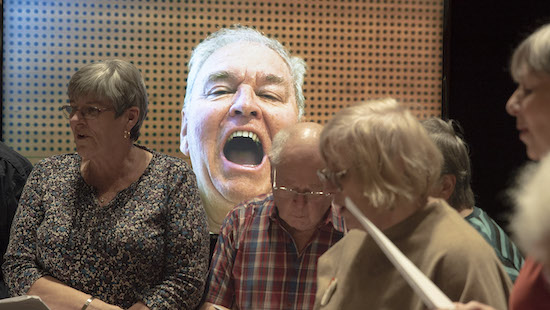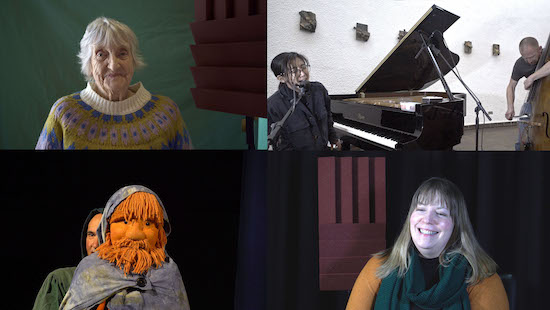“When I get up in the morning, I talk to myself to make sure that I’m still here,” says an elderly woman in a care home, as two companions chuckle wryly alongside her. They’re amongst a wide-ranging group of participants – from dementia patients to young adult carers, a football stadium announcer and bingo hall manager – selected by artist Benjamin Owen to contribute to his funny and tender installation The New Vocal Club, which has opened for a week in the foyer of Perth’s Horse Cross Theatre. The exhibition consists of a fifty-minute-long collage-style film without beginning or end, stitched together from interviews and performances with project participants. It plays alongside a hanging backdrop that reads “New Vocal Club” in fabric-patch lettering, like something between a DIY gig banner and a regional theatre set. A wall-based projection high up to the right shows a buzzing, vibrating soundwave, counterpointed with the rises and falls of the voices on screen.
For lots of people, our voices serve a less conscious function than for Owen’s elderly interlocutor (who, like all the participants in his show, is a named member of the Vocal Club, credited on posters). Making sounds in the mouth is a bodily function like walking or breathing. Speech and vocal gestures help to orientate us, both literally and in cultural terms: to make sense of the world around us and the people we encounter. We use our voices to arrange relationships and routines but also to check if anyone’s home when the lights are out.
What if we were gently, even imperceptibly, nudged towards a different relationship with the voice, one that involved noticing it, nurturing it, scrutinising it? What if we used it in our work: to sing, announce, keep score? Or what if we were in a foreign country, hearing ourselves form unfamiliar phonemes? What if we stuttered – like two of Owen’s older participants used to when they were younger – and felt words as balls of matter stuck at the top of our windpipes? For most members of the New Vocal Club, their voices have a somewhat augmented or evolved role, and they are encouraged on camera by Owen to talk about their voices as if they were external objects, or even living companions. A gentle kind of estrangement or alienation is fostered in a way that never feels intrusive.
For some, the voice is a tool. A young bingo announcer helps her dad, the bingo hall manager, by reading out the numbers, but she doesn’t like the sound of her voice when it comes through the speakers: her accent is too “common,” she thinks. Projecting the voice in situations like this, and hearing it artificially amplified, can often make it feel alien. Liam, the Stadium announcer for St. Johnstone FC, listens to his voice carry across the ground. He says he can pronounce all the home players’ names instinctively, but when he starts reading them out on camera he has several goes at a couple of them. Sometimes, perhaps, the skills we develop when speech is our tool are unconscious and can’t be called upon at will.
For others, the voice is an instrument. A Gaelic folk singer calls it “an instrument you can travel around with, without having to fit it in a case.” Improviser and pianist Shiori Usui vocalises into a microphone to a spidery double-bass soundtrack. (Her bandmate Seth Bennett, by contrast, says that “the bass is my voice,” a comment that frames the status of the voice by contrast – if an instrument can be your voice, your voice can be an instrument.) A local puppetry group talk about voicing the accents for their life-size models. When you’re singing, or inserting your voice into the artificially animated body of an eighty-year-old highland grannie, your voice might well start to seem distant from your body.

The New Vocal Club is inspired in formal terms by the maverick classical pianist Glenn Gould – most famous for his habit of humming or singing while he performed – specifically Gould’s idea of “contrapuntal radio”. As writer Neil Cooper explains in a text accompanying the show, the approach is defined by “independent melody lines play[ing] simultaneously.” Owen’s use of the idea for his film involves counterpointing image and sound, too, and uses speech as the melody line. There is no ostentatious sampling, repetition, cacophony, or any of the standard tricks we might associate with musique concrète. The doctoring of film and audio is subtle but makes itself periodically felt. One speaker’s thoughts accompany another’s bodily movements or pensive moments. Snippets of discussion repeat at long intervals, suggesting moments of déjà vu or snatches of memory and rational connection that the audience is invited to extrapolate from for themselves.
Several members of the New Vocal Club, including the Vocal Chord wellbeing choir, Bennett and Usui, took part in an opening night performance on November 4. This suggests an interest in the thresholds between art object and time-bound performance, but perhaps more importantly, it reflects Owen’s belief that all participants should be members of the “band.” The artist’s background is in rock and improv music, as well as arts education, and this carries across in the non-hierarchical ethos of his projects. Cooper discusses an earlier iteration of The New Vocal Club installed at Edinburgh’s Wee Red Bar: “[it] resembled a gig situation, with its opening event featuring live improvisation by an ad hoc quartet of musicians … As the audience drifted among and around them, the musicians responded to Owen’s audio-visual construction.”

To reflect on the voice as object might seem a diverting but ultimately dry, formalist pursuit. But it’s the geographical and sociological specificity of these voices that prevents that. Owen and his collaborators have created a kind of self-documenting mini-archive of Perthshire speech and culture. Several participants describe the peculiarities of the regional accent (“there are elements of the Highlands in there, elements of central Scotland…”) Meanwhile the vocal tics, pitch, and timbre of their voices both embody and overrun the formal traits put forward. Elderly participants sing folk songs. Magda, who moved to Perth seventeen years ago from Poland, talks about teaching Polish to students from her native country who have grown up speaking English. She is helping them to create new mouth-shapes and phonemes, and so nurturing a new, international generation of Perthshire accents.
There is also something deeper and more mysterious at work in the piece, a kind of underlying unity found amongst the melee of voices, which the artist describes to me in relation to rock music: “it’s like when you step outside of a practice room, you can hear the noise coming out of all the studios down the corridor. There are certain moments when it all just makes sense together.” Through the splicing and layering of voices, Owen’s film alights on subtle moments of harmony or attunement between them that gesture to some wider commonality in the way human beings feel, think, and interact with each other through speech and vocal gesture. A Chomskyan universal grammar, perhaps (if the reference isn’t too pompous). No wonder a care home resident might speak to themselves to check they’re still alive. Our voice is our point of access to our humanity, to ourselves and everyone else: a life line.


